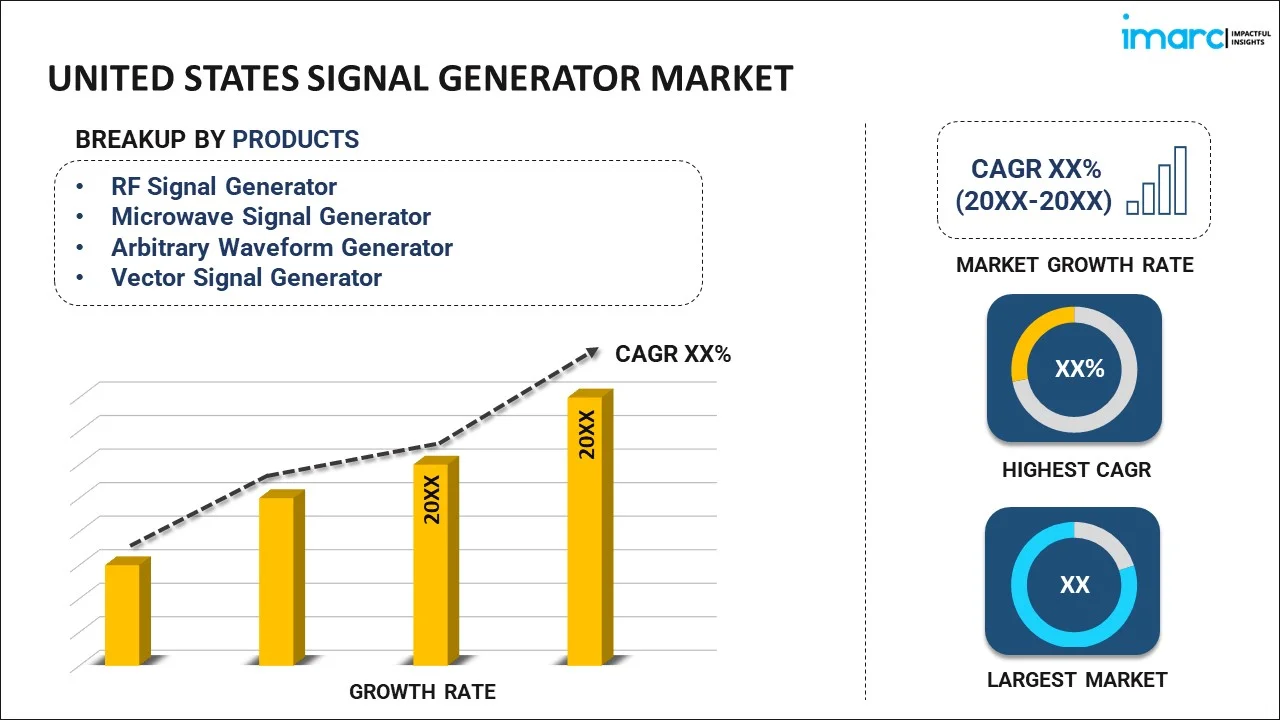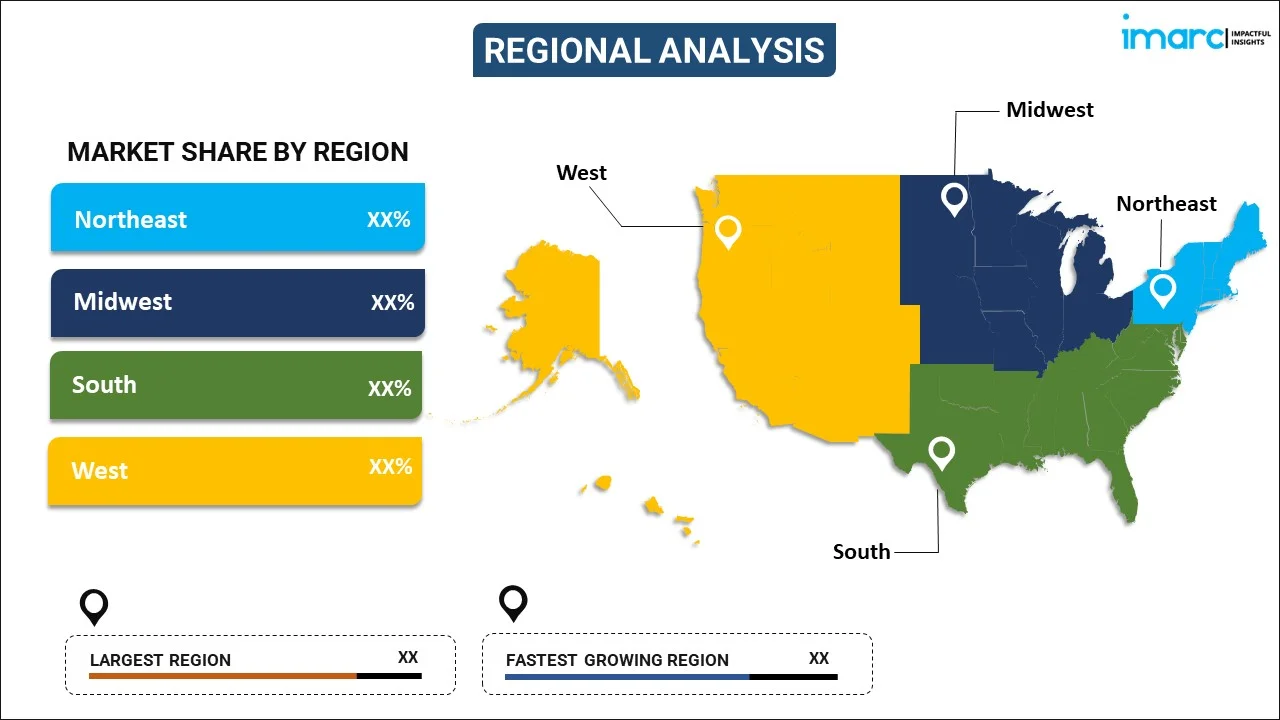
United States Signal Generator Market Report by Product (RF Signal Generator, Microwave Signal Generator, Arbitrary Waveform Generator, Vector Signal Generator), Technology (Global System for Mobile Phones (GSM), Code Division Multiple Access (CDMA), Wideband Code Division Multiple Access (WCDMA), Long Term Evolution (LTE), and Others), Application (Designing, Testing, Manufacturing, Troubleshooting, Repairing, and Others), End Use (Communications Industry, Aerospace and Defense Industry, Mechanical Industry, Electronics Industry, Healthcare, and Others), and Region 2025-2033
United States Signal Generator Market Size, Share & Analysis:
The United States signal generator market size reached USD 440.5 Million in 2024. Looking forward, IMARC Group expects the market to reach USD 730.4 Million by 2033, exhibiting a growth rate (CAGR) of 5.49% during 2025-2033. The fast-paced fifth generation (5G) and telecommunication growth, necessitating accurate testing equipment for sophisticated communication systems is impelling the United States signal generator market share. Increased defense and aerospace activities also drive demand because these sectors demand realistic signal simulation for radar, satellite, and electronic warfare technologies. Also, the growth of automotive electronics, particularly in electric and self-driving vehicles, creates a greater demand for signal generators to simulate testing on sensors, radars, and communication modules, which contribute to vehicle safety, reliability, and performance in intricate driving conditions.
|
Report Attribute
|
Key Statistics
|
|---|---|
|
Base Year
|
2024
|
|
Forecast Years
|
2025-2033
|
|
Historical Years
|
2019-2024
|
|
Market Size in 2024
|
USD 440.5 Million |
|
Market Forecast in 2033
|
USD 730.4 Million |
| Market Growth Rate (2025-2033) | 5.49% |
A signal generator refers to electronic equipment that generates periodic signals to test mechanical equipment. It creates repeating or non-repeating waveforms that are used to design, test, troubleshoot and repair electronic devices. Some of the commonly used signal generators include arbitrary waveform, audio, function, pulse, radio frequency (RF) and vector signal generators. They produce test signals, such as sine, square and triangular waves, to measure the frequency, output voltage, impedance, waveform and modulation generated by the device. As a result, signal generators find extensive applications across various industries, including defense, aerospace and telecommunication thus supporting the United States signal generator market demand.
Significant growth in the electronics industry is one of the key factors creating a positive outlook for the market. Furthermore, the increasing demand for mechanical testing equipment that provides precise and accurate results is providing a thrust to the market growth. Modern telecommunication systems extensively use signal generators for stable short and long-haul communications. Additionally, the use of vector signal generators and arbitrary waveform generators (AWG) to test and measure the circuits in Radio Detection and Ranging (RADAR) and Global Positioning System (GPS) is contributing to the United States signal generator market growth. Moreover, the aerospace industry is increasingly using signal generators to deliver prominent signal-to-noise ratio to detect and analyze small signal variations, thereby driving the market growth.
United States Signal Generator Market Trends:
Expansion of 5G and Telecom Infrastructure
The ongoing roll-out of 5G networks in the United States is a major United States signal generator market trend. As network performance is improved by mobile operators and telecom equipment vendors, they rely more and more on accurate and agile signal generators to verify and test communication systems. The devices are essential for guaranteeing high data rates, low latency, and stable connectivity over multiple frequency bands, such as millimeter waves. Furthermore, continued research into 6G technologies is generating demand for next-generation signal test equipment. This trend provokes industry makers to develop more advanced signal generators that can support intricate modulation patterns and wideband frequencies demanded by developing wireless standards. The increasing need for wireless connectivity in industries like IoT, smart cities, and industrial automation further increases the demand for reliable, flexible, and high-performance signal generation equipment.
Advancements in Defense and Aerospace Technologies
The defense and aerospace industries are significant drivers of the market, which is expected to witness robust growth as part of the broader U.S. signal generator market outlook. Military and aerospace equipment becomes increasingly sophisticated, creating a demand for highly precise and stable signal generation equipment. Designing, testing, and maintaining radar systems, satellite communications, electronic warfare systems, and navigation systems all depend heavily on signal generators. Equipment capable of simulating severe operating conditions and producing complicated waveforms is needed for these applications. Signal generators are a crucial component of the extensive testing required to ensure that advanced military vehicles operate dependably in a variety of scenarios. Further, the trend towards more advanced avionics, unmanned aerial vehicles, and space exploration systems generates need for high-frequency, low-noise signal generators to aid in research, development, and production of these mission-critical systems.
Rise in Automotive Electronics and Autonomous Technologies
Another significant trend is the rising emphasis on cutting-edge electronics and autonomous vehicle (AVS) technology thus fueling U.S. market demand for signal generators. Advanced systems like radar, LiDAR, communications modules, and other sensors are integrated into the latest vehicles. During their development, these systems need to be thoroughly tested and calibrated. With the aid of signal generators, engineers can model real-world scenarios and ensure that these systems are operating correctly in a lab environment. The demand for electric vehicles, connected car applications, and driver-assistance systems adds to the complexity of vehicle electronics, and precise signal simulation becomes more critical. By guaranteeing that sensor systems and electronic control units perform as designed under all circumstances, ranging from straightforward road driving to autonomous driving in adverse conditions, these technologies enable automakers to create safer, more reliable, and fuel-efficient vehicles.
Key Market Segmentation:
IMARC Group provides an analysis of the key trends in each sub-segment of the United States signal generator market report, along with forecasts at the country level from 2025-2033. Our report has categorized the market based on product, technology, application, and end use.
Breakup by Product:

- RF Signal Generator
- Microwave Signal Generator
- Arbitrary Waveform Generator
- Vector Signal Generator
Breakup by Technology:
- Global System for Mobile Phones (GSM)
- Code Division Multiple Access (CDMA)
- Wideband Code Division Multiple Access (WCDMA)
- Long Term Evolution (LTE)
- Others
Breakup by Application:
- Designing
- Testing
- Manufacturing
- Troubleshooting
- Repairing
- Others
Breakup by End Use:
- Communications Industry
- Aerospace and Defense Industry
- Mechanical Industry
- Electronics Industry
- Healthcare
- Others
Breakup by Region:

- Northeast
- Midwest
- South
- West
Competitive Landscape:
The competitive landscape of the industry has also been examined along with the profiles of the key players.
Report Coverage:
| Report Features | Details |
|---|---|
| Base Year of the Analysis | 2024 |
| Historical Period | 2019-2024 |
| Forecast Period | 2025-2033 |
| Units | Million USD |
| Segment Coverage | Product, Technology, Application, End Use, Region |
| Regions Covered | Northeast, Midwest, South, West |
| Customization Scope | 10% Free Customization |
| Post-Sale Analyst Support | 10-12 Weeks |
| Delivery Format | PDF and Excel through Email (We can also provide the editable version of the report in PPT/Word format on special request) |
Key Questions Answered in This Report
We expect the United States signal generator market to exhibit a CAGR of 5.49% during 2025-2033.
The extensive utilization of signal generators in modern high-speed communication systems, such as 5G and Wi-Fi, owing to their high signal purity and frequency stability, is primarily driving the United States signal generator market.
The sudden outbreak of the COVID-19 pandemic has led to the growing adoption of signal generators across the nation, owing to the increasing demand for advanced communication systems as organizations are opting for the work-from-home model.
Based on the product, the United States signal generator market can be segmented into RF signal generator, microwave signal generator, arbitrary waveform generator, and vector signal generator. Currently, RF signal generator holds the majority of the total market share.
Based on the technology, the United States signal generator market has been divided into Global System for Mobile Phones (GSM), Code Division Multiple Access (CDMA), Wideband Code Division Multiple Access (WCDMA), Long Term Evolution (LTE), and others. Among these, Global System for Mobile Phones (GSM) currently exhibit a clear dominance in the market.
Based on the application, the United States signal generator market can be categorized into designing, testing, manufacturing, troubleshooting, repairing, and others. Currently, designing accounts for the largest market share.
On a regional level, the market has been classified into Northeast, Midwest, South, and West, where South currently dominates the United States signal generator market.
Need more help?
- Speak to our experienced analysts for insights on the current market scenarios.
- Include additional segments and countries to customize the report as per your requirement.
- Gain an unparalleled competitive advantage in your domain by understanding how to utilize the report and positively impacting your operations and revenue.
- For further assistance, please connect with our analysts.
 Request Customization
Request Customization
 Speak to an Analyst
Speak to an Analyst
 Request Brochure
Request Brochure
 Inquire Before Buying
Inquire Before Buying




.webp)




.webp)












